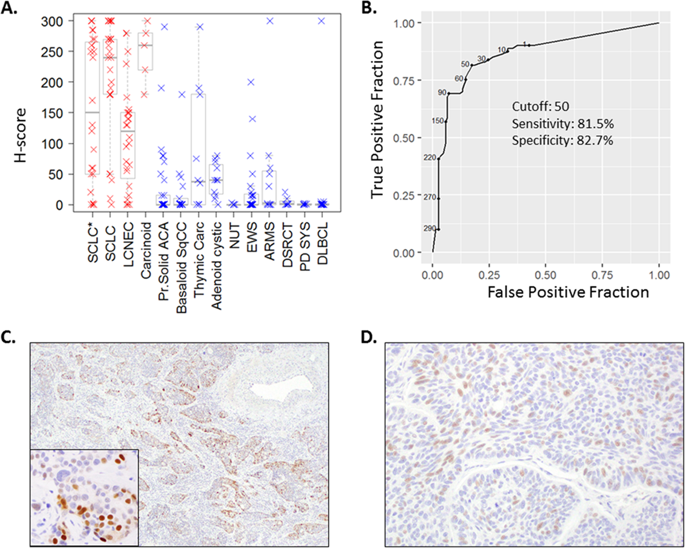Modern Pathology ( IF 7.5 ) Pub Date : 2020-03-12 , DOI: 10.1038/s41379-020-0517-0 Harrison K Tsai 1 , Jason L Hornick 1 , Marina Vivero 1

|
INSM1 is a diagnostic marker for neuroendocrine tumors originating in multiple anatomic sites. In the lung, INSM1 shows 76–97% sensitivity for neuroendocrine tumors overall. Our aim was to characterize INSM1 as a diagnostic marker for small cell carcinoma in the context of its epithelial, lymphoid, and mesenchymal morphologic mimics. Immunohistochemistry was performed on 231 tumors, including lung neuroendocrine tumors, nonneuroendocrine carcinomas of the thoracic cavity, diffuse large B-cell lymphomas, and small round cell sarcomas, using an anti-INSM1 mouse monoclonal antibody. Extent (0–100%) and intensity (1–3+) of nuclear INSM1 staining was multiplied in each case to calculate an H-score. Demographic and clinical information was obtained from the medical record. INSM1 had an overall sensitivity and specificity of 81.5% and 82.7% for small cell carcinoma, respectively, using a threshold established with a receiver operating characteristic curve. 40/48 (82.7%) small cell carcinomas were positive for INSM1, including 19/24 (79%) small cell carcinomas that were negative for chromogranin and synaptophysin. 5/5 carcinoids and 21/28 (75%) large cell neuroendocrine carcinomas showed INSM1 expression. Among nonneuroendocrine tumors, 7/38 (18%) lung adenocarcinomas, 2/17 (12%) lung squamous cell carcinomas, 4/10 (40%) thymic carcinomas, 4/12 (33%) adenoid cystic carcinomas, 1/19 (5%) diffuse large B-cell lymphomas, 4/11 (36%) alveolar rhabdomyosarcomas, and 4/23 (17%) Ewing sarcomas were positive for INSM1. No synovial sarcomas or desmoplastic small round cell tumors were positive. Weak, focal INSM1 expression alone is insufficient as a diagnostic marker for small cell carcinoma, but is sensitive and specific, easy to interpret in small biopsies, and makes a valuable addition to a diagnostic panel.
中文翻译:

INSM1 在胸部恶性肿瘤和小圆细胞肿瘤子集中的表达:小细胞癌的罕见潜在陷阱。
INSM1 是起源于多个解剖部位的神经内分泌肿瘤的诊断标志物。在肺部,INSM1 对神经内分泌肿瘤的总体敏感性为 76-97%。我们的目标是在其上皮、淋巴和间充质形态学模拟物的背景下将 INSM1 表征为小细胞癌的诊断标志物。使用抗 INSM1 小鼠单克隆抗体对 231 种肿瘤进行了免疫组织化学分析,包括肺神经内分泌肿瘤、胸腔非神经内分泌癌、弥漫性大 B 细胞淋巴瘤和小圆细胞肉瘤。在每种情况下,将核 INSM1 染色的范围 (0–100%) 和强度 (1–3+) 相乘以计算 H 分数。从医疗记录中获得人口统计和临床信息。INSM1 的总体敏感性和特异性分别为 81.5% 和 82。7% 分别用于小细胞癌,使用通过接受者操作特征曲线建立的阈值。40/48 (82.7%) 小细胞癌对 INSM1 呈阳性,包括 19/24 (79%) 对嗜铬粒蛋白和突触素呈阴性的小细胞癌。5/5 类癌和 21/28 (75%) 大细胞神经内分泌癌显示 INSM1 表达。在非神经内分泌肿瘤中,7/38 (18%) 肺腺癌、2/17 (12%) 肺鳞状细胞癌、4/10 (40%) 胸腺癌、4/12 (33%) 腺样囊性癌、1/19 (5%) 弥漫性大 B 细胞淋巴瘤、4/11 (36%) 肺泡横纹肌肉瘤和 4/23 (17%) 尤文肉瘤 INSM1 呈阳性。没有滑膜肉瘤或促结缔组织增生性小圆细胞瘤呈阳性。仅弱的局灶性 INSM1 表达不足以作为小细胞癌的诊断标志物,



























 京公网安备 11010802027423号
京公网安备 11010802027423号